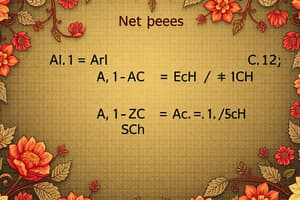Podcast
Questions and Answers
What indicates the presence of sulfate ions in a solution?
What indicates the presence of sulfate ions in a solution?
- A white precipitate of barium sulfate forms (correct)
- A yellow precipitate of lead sulfate forms
- A white precipitate of barium chloride forms
- A colorless gas is released
In the reaction SO42- (aq) + Ba2+ (aq) -> BaSO4 (s), what does BaSO4 represent?
In the reaction SO42- (aq) + Ba2+ (aq) -> BaSO4 (s), what does BaSO4 represent?
- A white precipitate (correct)
- A soluble salt
- An acidic solution
- A gas
Which ion is reacted with sulfate ions to form a precipitate in the given reaction?
Which ion is reacted with sulfate ions to form a precipitate in the given reaction?
- Ag+
- Ca2+
- Na+
- Ba2+ (correct)
What is the charge of sulfate ions in the reaction?
What is the charge of sulfate ions in the reaction?
Which of the following best describes the appearance of barium sulfate when formed?
Which of the following best describes the appearance of barium sulfate when formed?
What effect does stress have on the structure of ionic compounds?
What effect does stress have on the structure of ionic compounds?
What is the primary reason for the stability of carbocation A over carbocation B?
What is the primary reason for the stability of carbocation A over carbocation B?
Which characteristic is NOT typical of ionic compounds?
Which characteristic is NOT typical of ionic compounds?
What is the nature of covalent bonding?
What is the nature of covalent bonding?
Which carbocation is more likely to form the major product in a reaction?
Which carbocation is more likely to form the major product in a reaction?
What can be inferred about the formation of carbocation A in comparison to carbocation B?
What can be inferred about the formation of carbocation A in comparison to carbocation B?
What enables ionic compounds to dissolve in water?
What enables ionic compounds to dissolve in water?
Ionic compounds are described as brittle because:
Ionic compounds are described as brittle because:
Which statement accurately describes the properties of carbocation A relative to carbocation B?
Which statement accurately describes the properties of carbocation A relative to carbocation B?
Why does carbocation A contribute to the major product formation instead of carbocation B?
Why does carbocation A contribute to the major product formation instead of carbocation B?
What type of reaction involves two reactants combining to form only one product?
What type of reaction involves two reactants combining to form only one product?
Which of the following best describes a substitution reaction?
Which of the following best describes a substitution reaction?
In organic chemistry, oxidation is characterized by what changes?
In organic chemistry, oxidation is characterized by what changes?
Which type of reaction is NOT typically characterized by the formation of two products?
Which type of reaction is NOT typically characterized by the formation of two products?
What is the primary distinction between addition and substitution reactions?
What is the primary distinction between addition and substitution reactions?
What is the purpose of Hund's rule in electron configuration?
What is the purpose of Hund's rule in electron configuration?
What does ionization energy measure?
What does ionization energy measure?
How should electrons be arranged in orbitals according to Hund’s rule?
How should electrons be arranged in orbitals according to Hund’s rule?
Which statement regarding ionization energy is accurate?
Which statement regarding ionization energy is accurate?
Which of the following statements about electron pairing is correct?
Which of the following statements about electron pairing is correct?
What is the representation for the second ionisation energy of an element X?
What is the representation for the second ionisation energy of an element X?
Which equation correctly relates the logarithm of ionisation energy using the given variables?
Which equation correctly relates the logarithm of ionisation energy using the given variables?
What is the significance of the term 'second ionisation energy'?
What is the significance of the term 'second ionisation energy'?
How does ionisation energy generally change across a period in the periodic table?
How does ionisation energy generally change across a period in the periodic table?
What factor does NOT affect ionisation energy?
What factor does NOT affect ionisation energy?
Flashcards
Sulfate Test
Sulfate Test
The test for sulfates uses a solution of barium ions (Ba2+) to detect their presence.
Barium Sulfate Precipitate
Barium Sulfate Precipitate
The presence of sulfate ions in the solution is indicated by the formation of a white precipitate.
Barium Sulfate
Barium Sulfate
Barium sulfate (BaSO4) is a white solid that is insoluble in water.
Sulfate Ions (SO42-)
Sulfate Ions (SO42-)
Signup and view all the flashcards
Aqueous Solution
Aqueous Solution
Signup and view all the flashcards
Ionization Energy
Ionization Energy
Signup and view all the flashcards
Hund's Rule
Hund's Rule
Signup and view all the flashcards
Ionization
Ionization
Signup and view all the flashcards
Orbital
Orbital
Signup and view all the flashcards
Electron Configuration
Electron Configuration
Signup and view all the flashcards
Covalent Bonding
Covalent Bonding
Signup and view all the flashcards
Shared pair of electrons
Shared pair of electrons
Signup and view all the flashcards
Covalent bond
Covalent bond
Signup and view all the flashcards
Ionic substance with covalent character
Ionic substance with covalent character
Signup and view all the flashcards
Electrostatic attraction in covalent bonding
Electrostatic attraction in covalent bonding
Signup and view all the flashcards
Second Ionisation Energy
Second Ionisation Energy
Signup and view all the flashcards
Nuclear Charge and Ionisation Energy
Nuclear Charge and Ionisation Energy
Signup and view all the flashcards
Atomic Radius and Ionisation Energy
Atomic Radius and Ionisation Energy
Signup and view all the flashcards
Electron Shielding and Ionisation Energy
Electron Shielding and Ionisation Energy
Signup and view all the flashcards
Electron Configuration and Ionisation Energy
Electron Configuration and Ionisation Energy
Signup and view all the flashcards
Addition Reaction
Addition Reaction
Signup and view all the flashcards
Substitution Reaction
Substitution Reaction
Signup and view all the flashcards
Oxidation (Organic Chemistry)
Oxidation (Organic Chemistry)
Signup and view all the flashcards
Redox Reaction
Redox Reaction
Signup and view all the flashcards
Reduction (Organic Chemistry)
Reduction (Organic Chemistry)
Signup and view all the flashcards
Carbocation Stability
Carbocation Stability
Signup and view all the flashcards
Carbocation Formation
Carbocation Formation
Signup and view all the flashcards
Major Product Formation
Major Product Formation
Signup and view all the flashcards
Role of Alkyl Groups
Role of Alkyl Groups
Signup and view all the flashcards
Charge Delocalization
Charge Delocalization
Signup and view all the flashcards
Study Notes
Topic 1: Formulae, Equations, and Amount of Substance
- Simplifying ionic equations involves writing the normal equation, replacing reactants and products with ions, and then removing spectator ions.
- If a solid product forms in a solution reaction, only the ions involved in forming the solid product are written in the simplified equation. Other ions are spectator ions and are omitted.
- Acid reactions with metals produce salt and hydrogen gas.
- Acid reactions with metal oxides produce salt and water.
- Acid reactions with metal hydroxides produce salt and water.
- Acid reactions with alkalis produce salt and water.
- Acid reactions with metal carbonates produce salt, water, and carbon dioxide gas.
- Acid reactions with hydrogencarbonates produce salt, water, and carbon dioxide gas.
- Displacement reactions are redox reactions.
- Double displacement reactions are not redox reactions and no oxidation number change.
- Precipitation reactions involve the formation of a solid product from ions in solution.
- The test for carbon dioxide involves adding it to limewater. Limewater turns from clear to milky if carbon dioxide is present.
- The test for sulfates involves adding barium ions. Barium sulfate precipitates as a white solid if sulfate ions are present.
- The test for halides involves adding silver ions. Silver halides precipitate as a solid if halide ions are present.
Topic 2: Atomic Structure and the Periodic Table
- Relative atomic mass is the weighted average mass of an atom, compared to 1/12 the mass of a carbon-12 atom.
- Mole calculations include calculations for moles from mass and molar mass, percent yield calculations, atom economy calculations, and volume calculations.
- Mass spectrometry vaporizes a sample into a gas.
- High energy electrons ionize the gas vapor.
- An electric or magnetic field deflects the positive ions.
- The strength of the field determines the amount of deflection, which depends on the ion's mass-to-charge ratio (m/z).
- The relative abundance of ions is represented as a spectrum.
Topic 3: Bonding and Structure
- Ions attract each other due to electrostatic attraction.
- Ionic bonding involves electrostatic attraction between oppositely charged ions.
- The smaller the ion and the larger its charge, the more energy is needed to overcome the attraction.
- Ionic compounds are brittle and conduct electricity when molten.
- Metallic bonding involves delocalized electrons surrounding positive ions.
- Metals have high melting points and are good conductors of electricity.
- Covalent bonding involves sharing electron pairs between atoms.
- Covalent bonds can be σ (sigma) or π (pi) bonds.
- The strength of a covalent bond depends on bond length – shorter bonds are stronger.
- Electronegativity is an atom's ability to attract bonding electrons in a molecule and is given values on a scale.
Topic 4: Introductory Organic Chemistry and Alkanes
- Alkane general formula is CnH2n+2
- Alkanes are saturated hydrocarbons, meaning they consist only of carbon-carbon single bonds.
- Displayed, structural, and skeletal formulas describe organic compounds.
- Functional groups give specific properties to molecules.
- Alkanes are generally unreactive and undergo substitution reactions.
- Structural isomers have the same molecular formula but different structural arrangements.
- Cycloalkanes are different cyclic forms of alkanes.
Topic 5: Addition Reactions of Alkenes
- Alkenes are unsaturated hydrocarbons with at least one carbon-carbon double bond (C=C).
- Addition reactions involve the addition of atoms or groups to the double bond (C=C).
- Hydrogenation (adding hydrogen) forms alkanes.
- Halogenation (adding halogens) forms dihalogenoalkanes.
- Hydration (adding water) forms alcohols.
- Addition of hydrogen halides forms halogenoalkanes.
- Oxidation to diols involves addition of water and oxidation.
Topic 6: Electrophilic Addition of Hydrogen Halides
- Halogens are not polar but electrons in the C=C bond can induce polarity.
- Electrophilic addition involves the attack of a positive species (electrophile) on a molecule with high electron density.
- During the reaction, an intermediate carbocation is formed (positive ion). Bromine ions are attracted to the positive carbocation for covalent bond formation.
Additional information
- The text covers several topics within organic, inorganic, and physical chemistry.
- Concepts include reactions, properties, and bonding.
- Data and examples are provided to illustrate these concepts.
- Techniques like mass spectrometry, chemical tests (for example, the limewater test), and determining relative molecular masses (e.g., from chlorine mass spectrum) are described.
Studying That Suits You
Use AI to generate personalized quizzes and flashcards to suit your learning preferences.




